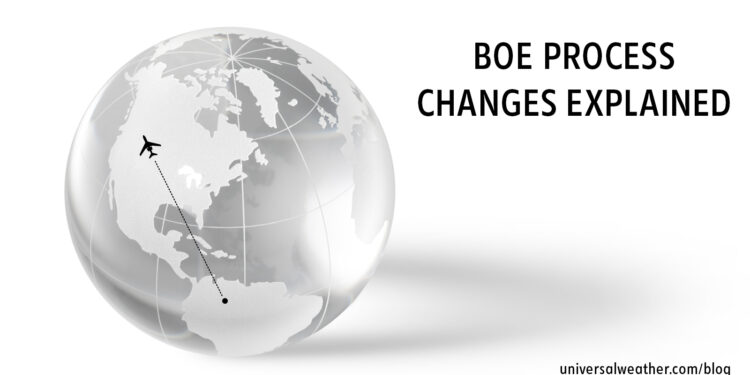UPDATE: Border Overflight Exemptions – Positive Impacts from Recent Changes

As of June 17, 2013, significant changes for the better were implemented to Customs and Border Protection’s (CBP’s) Border Overflight Exemption (BOE) process. The end result is that annual BOEs are now user-friendlier in terms of the approval process and operations. Business aviation benefits are significant and, in some cases, have dramatically improved operating flexibility and reduced day-to-day operational costs.
The following is an overview of what you need to know:
1. BOEs are relatively straightforward to obtain and manage
A BOE allows an operator to overfly the first designated Airport of Entry (AOE) when arriving into the U.S. from below the 30th parallel in the eastern U.S. and below the 33rd parallel in the western U.S. This covers all flights from the Caribbean, Mexico, Central and South America, and (in some cases) French Polynesia. All criteria set forth on the BOE approval must be met in order to use them for your flight. If you are using a BOE, it should be listed in remarks section 18 of your flight plan. Without at BOE, you must land at the first-designated AOE. Note: BOEs are valid for two years.
2. Any aircraft can qualify for a BOE
Any aircraft, regardless of country of registry, can qualify for a BOE. It’s an operator-vetting process which qualifies the crew and, in certain cases, passengers. Sometimes a BOE approval may come with omissions of certain crew members who’ve not been approved. The BOE coordinator will inform the party requesting the BOE if a particular crew member has not been approved. For instance, he or she may be a “person of interest,” or there may be a more significant issue.
3. Both single-trip and annual BOEs are available
Some operators – air ambulance providers, for example – may choose to apply for single-trip BOEs, and these can be secured on relatively short notice. For single-trip BOEs, you’ll need to have everything approved, including departure/destination points, as well as all crew members and passengers. Expect 15 business days for single-trip BOE approvals. Annual BOEs are valid for 12 months from date of approval, although some ports approve BOEs for as long as 24 months. Approval for an annual BOE takes a maximum of 30 days – depending upon workload of the BOE coordinator. Annual approvals are the most commonly requested BOEs.
4. Recent changes to BOE approvals impact only annual approvals
As of June 17, 2013, annual BOE approvals no longer require passengers to be onboard to take advantage of BOE benefits. Additionally, in the case of annual BOEs, no departure points or destinations need to be provided, so long as the destination airport is manned by U.S. customs. (Previously [and this is still the case with single-trip BOEs] at least one passenger had to be onboard in order to take advantage of BOE benefits and to overfly designated border airports.) This change is a significant operational benefit for both operators and the business aviation industry.
5. Know how to apply for a BOE
Operators should request their BOE from the area in which they’re based or to which they typically fly. When planning, expect the official 30 days’ lead time for a new BOE approval or revision to an existing BOE. Some ports are busier than others – notably Los Angeles (KLAX) and Newark (KEWR) – and may take a little longer to process BOE approvals. As recent BOE amendments have decreased processing workload, fewer BOE amendments are now needed, and the approval and revision process should not be unduly lengthy.
6. Understand BOE policy and policy changes
Recent changes to annual BOE requirements are a direct result of Advance Passenger Information System (APIS) and the necessity of all flights to file APIS. As APIS filing already vets passengers and provides departure/destination airports, it became practical to modify and simplify BOE approval requirements.
7. Know required information
A Form 442 or 442A may need to be completed and submitted by the operator or operator’s representative. Note that these forms were officially retired by CBP as of August 2012. These forms are still, however, used at the discretion of BOE coordinators and are no longer available online via CBP’s website.
8. 3rd-party providers may still assist with BOE approval requests
As was the case previously, your designated 3rd-party provider is still authorized to apply for a BOE approval on an operator’s behalf.
9. Be aware of BOE revision requirements
Any change to aircraft, crew, or operator (such as operator name, address, etc.) requires a BOE revision. Turnaround time for BOE revisions is at the discretion of the BOE coordinator. In most cases, revisions can be accomplished well within the official 30 days’ lead time.
10. Best practices when using a BOE
A copy of your BOE should always be carried onboard. Be aware that BOE approval is always checked, and reconfirmed, whenever an operator requests landing rights at an airport.
Conclusion
Ability to overfly a border airport, and continue directly to your planned destination, cuts down on flight time, aircraft cycles, and crew duty time and can potentially save larger operators hundreds of thousands of dollars per year. Now that it’s possible to take advantage of annual BOE benefits with only crew members onboard, operator benefits have become even more significant. This very positive regulatory change is a direct result of an effective partnership between the NBAA Security Council, business aviation industry, and the CBP.
Questions?
If you have questions about this blog article or would like more information on aviation regulatory services, contact us at lauraeverington@univ-wea.com or saadfarid@univ-wea.com.




